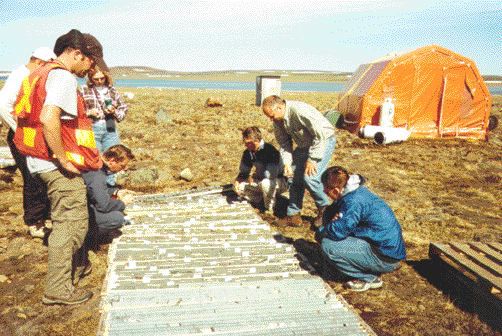New resource calculations, based on 2004 drilling by
Stepout drilling last summer and fall intersected mineralization along the northeastern strike extension of the known Mequillon resource, so the increase in tonnage is not a surprise. The new estimate includes another 700 metres of strike length.
Mequillon’s resource, calculated by consulting firm Strathcona Mineral Services, now stands at 4.2 million tonnes grading 0.6% nickel, 0.9% copper, 0.03% cobalt, 0.7 gram platinum, 2.4 grams palladium and 0.2 gram gold per tonne. That is an indicated resource, upgraded from the inferred resource, calculated in 2003, of 1.4 million tonnes averaging 0.7% nickel, 0.9% copper, 0.03% cobalt, 0.6 gram platinum, 2.1 grams palladium and 0.2 gram gold per tonne.
The new resource breaks down into a shallow zone defined by a conceptual open-pit design, and a deeper zone of blocks defined by underground mining constraints. The shallow zone is an indicated resource of 1.9 million tonnes at 0.6% nickel, 0.8% copper, 0.03% cobalt, 0.6 gram platinum, 2.1 grams palladium and 0.2 gram gold per tonne, based on a composite cutoff grade representing a net smelter return of $40 per tonne. It includes an assumption of 19% dilution by waste with zero grades.
About 75,000 tonnes of oxidized material, near the surface, has been kept out of all the Mequillon resource estimates so far.
The deeper zone contains 2.3 million tonnes at 0.7% nickel, 1% copper, 0.03% cobalt, 0.7 gram platinum, 2.6 grams palladium and 0.2 gram gold per tonne. Strathcona’s basis for the resource was a cutoff net smelter return of $80 per tonne, and the resource includes 5% dilution.
There is an inferred resource of another 167,000 tonnes, averaging 0.8% nickel, 1% copper, 0.04% cobalt, 0.7 gram platinum, 2.4 grams palladium and 0.2 grams gold per tonne. It is all in the underground zone.
Strathcona also revised its estimate on the Mesamax deposit, like Mequillon on the Raglan South trend of the Cape Smith belt. The deposit is now estimated to have 1.8 million tonnes grading 2.1% nickel, 2.6% copper, 0.08% cobalt, 1 gram platinum, 3.8 grams palladium and 0.2 gram gold per tonne. Its tonnage has increased only marginally from a 2003 resource estimate, but its nickel grade has increased from 1.9% and its copper grade from 2.3%.
The Mesamax estimate breaks out into a higher-grade massive zone, partly oxidized and partly fresh, and a net-textured zone at grades comparable to Mequillon.
Based on an assumption of a 1-metre envelope of low-grade material around the resource, another 230,000 tonnes (grading 0.1% nickel and 0.3% copper, with trace cobalt and precious metal credits) of dilutive material could be added to the resource for any pit design.
Strathcona offered the opinion that a limited number of holes in the upper part of the Mequillon deposit would be enough to allow a full feasibility study. Considerably more drilling will still be needed on the deeper resources before they can be converted to reserves.


Be the first to comment on "Resource figure for Mequillon deposit grows"